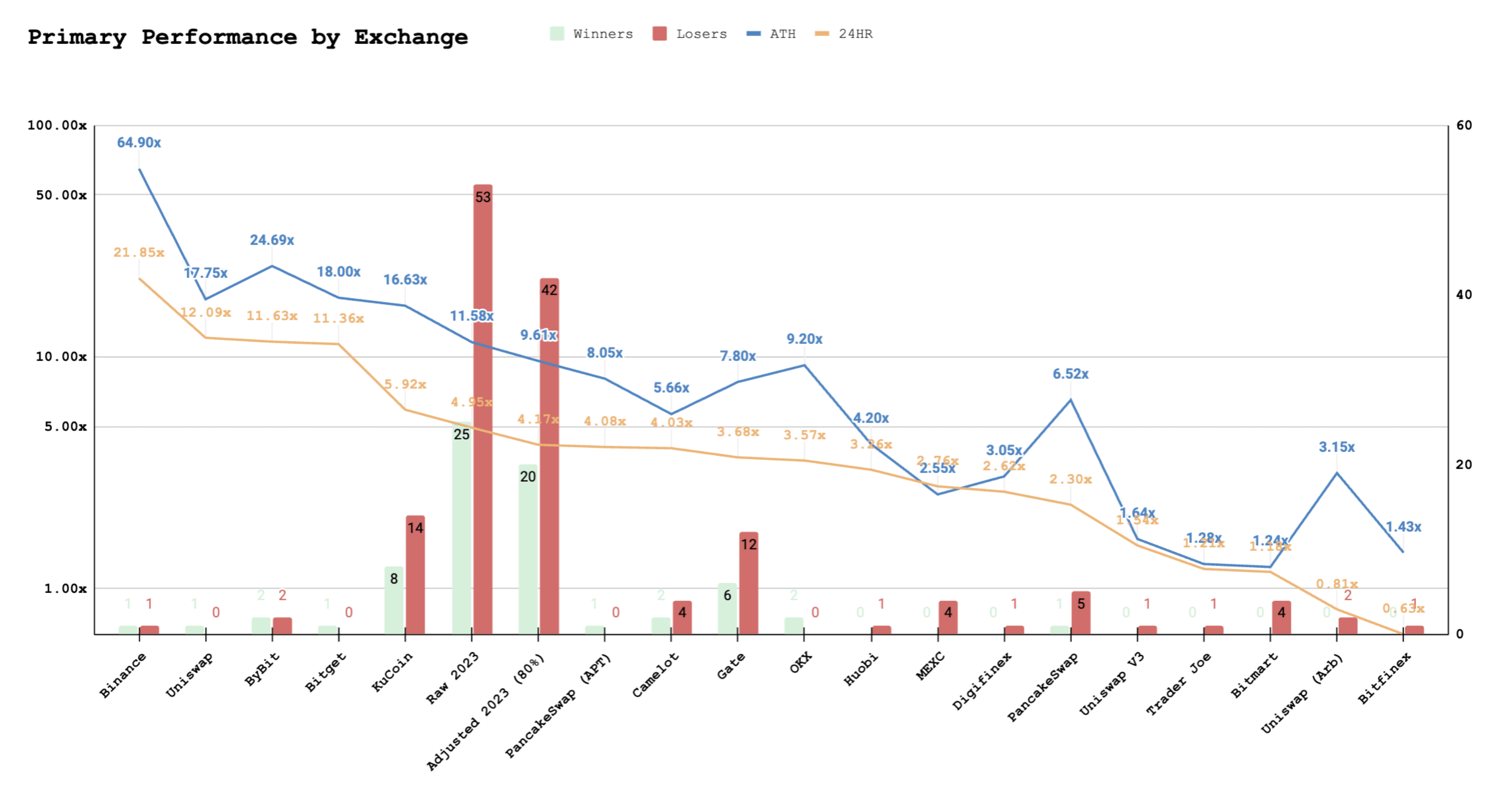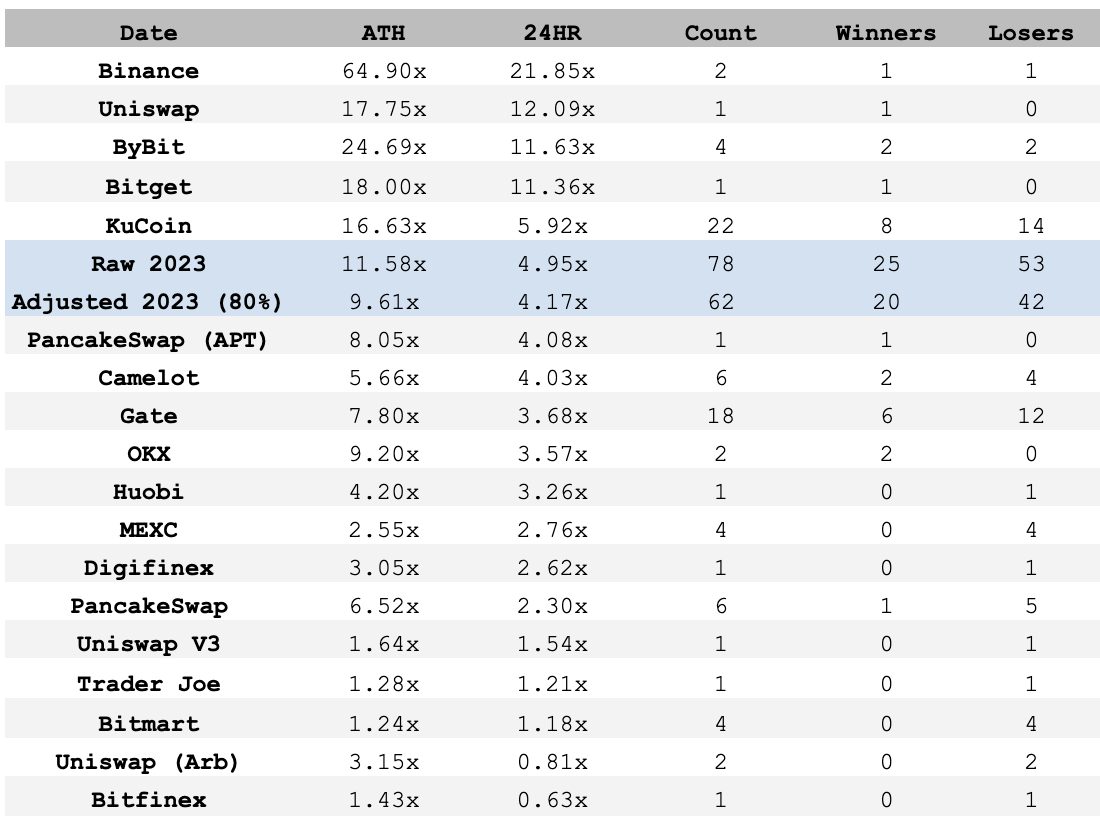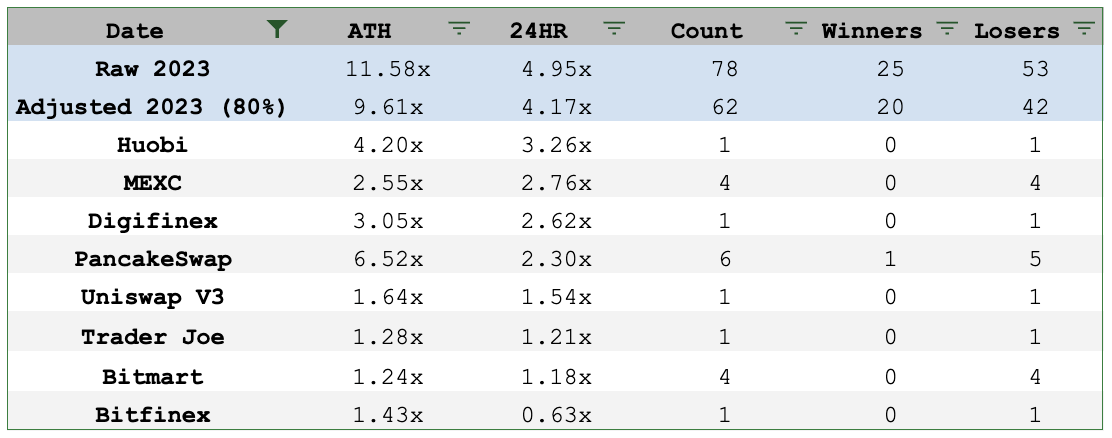Analyzing Cryptocurrency Primary Listing Performance in 2023 (Updated June 6, 2023)
Introduction

We believe that a token’s primary listing can be considered one of the most important, if not the most important, moments in a token’s price performance. For most tokens, this event will bring in the highest organic volumes and establishes the groundwork for subsequent price discovery.
In this blog post, we will analyze the performance of tokens listed on different exchanges, both centralized and decentralized, through the first five months of 2023. By leveraging data taken from these exchanges and other publicly available information, we will analyze the effectiveness and success of each exchange. We will focus on key metrics such as the number of qualified listings, winners, losers, average ATH (All-Time High) multiples, and 24-hour multiples. This analysis aims to provide valuable insights into the performance of tokens on specific exchanges.
Following this analysis, we will outline our expectations for the industry in the near future as it pertains to the exchange landscape.
Before we begin to look at the data, please keep in mind that this list is not exhaustive and does not include all primary listings for 2023.
Key Notes
There are few key distinctions to be made before we take a deeper dive into the data.
One of the more important is qualified listings. When debating whether or not we should track a listing, we consider launch venue, key investors, project quality, funding amount, launchpad venue, and social interaction. If a baseline number is reached among all of these variables then we will track the listing.
The majority of this data is sourced from cryptorank.io to which we found funding and launch information. A minimum of $250,000 must have been raised to be considered. However, not all launches had easily accessible funding amounts to which we relied heavily on the other factors listed above.
The second distinction is that primary token listings can occur on multiple platforms simultaneously. For example, a particularly common primary listing play for the past few months has been the trio of KuCoin, Gate.io, and ByBit. This occurred at least 11 times in the 78 qualified listings that we tracked since the beginning of the year. As a rule of thumb, we typically attribute the listing to the venue that is most publicized by the issuer.
The third distinction is the qualification of success or failure of a listing. To determine a winner or a loser, we compare a listing’s performance to the Adjusted 2023 Multiples. If a listing’s multiple reaches 75% of the Adjusted 2023 ATH while settling above at least 33% of its own ATH then it is determined a winner. If it fails this criteria then it is determined a loser. The goal here is to extract premarket order biases and reward listings who supply quote liquidity at relatively reasonable price levels.
Lastly, there, unfortunately, exists inorganic trading behaviors at play on almost all of these trading platforms and it is nearly impossible to extract these from the data set. For this reason, we do not value volumes when determining launch success.

Unfiltered Data - Jan 2023 to May 2023
Table Notes:
ATH - All time high multiple typically within the first 24 hours of a primary listing
24 hr multiple - The price multiple at the 24 hr close
Count - The number of qualified listings on the exchange
Winners - Qualified listings which achieve ATH multiples greater than 75% of the Adjusted 2023 ATH with prices settling above 33% of the ATH after 24hrs
Losers - Qualified listings which do not fulfill the above criteria
Discussion

Through 2023, we have found 78 qualified listings of which 25 were determined winners and 53 were determined to be losers. Thus, only 32% of qualified listings could be considered winners. This is an extremely small subset of listings to start the year. The average ATH multiple across these listings was 11.579x while the average 24 hour multiple closed at 4.948x.
However, not all winners and losers are equal. For that reason, the Adjusted 2023 line trims the data set to ignore the upper and lower 10% of listings. By shrinking the data set, the average ATH lowers to 9.6x and the 24 hr multiple to 4.17x. These numbers can be used as a baseline for comparison across venues but should not be considered as an expectation for a future listing. The structure of a premarket listing can vastly alter how a listing performs along with a laundry list of additional dynamic, ever-changing factors.
Class A

Binance reigns supreme as the top listing venue and has had the most successful launch of the year so far: SPACE ID. Even with only two qualified listings, Binance’s organic flow is unparalleled in comparison to the other exchanges discussed in this analysis leading them to be in a class of their own.
Once again, please keep in mind that this list is not exhaustive. Exchanges like Coinbase and Kraken, who are premier exchanges, did not have a qualified listing.
Class B

Through our analysis, we found four exchanges that on average outperform the Adjusted 2023 multiples including Binance. The remaining three exchanges are Uniswap, ByBit, and KuCoin. Both ByBit and KuCoin demonstrated strong retail demand on open and within an asset’s first 24 hours. We, generally, see these two as equals however recent regulatory may have tilted this battle in ByBit’s favor.
On the other hand, Uniswap may appear to have only one data point but as mentioned above primary exchange listings can occur on multiple platforms simultaneously. Our data suggests that Uniswap V2 on Ethereum is still the premier DEX listing venue.
Class C

The next tier of exchanges are two commonly known centralized exchanges and a new decentralized exchange who took advantage of a narrative at the right time. Gate and OKX both performed just below average compared to industry adjusted averages since the start of the year. Gate, in particular, had the second most primary listings and participated most as the launchpad through Gate.io Startup.
In fact, it was commonplace to see an exchange launchpad as one of the primary marketing venues for many tokens listed as ByBit, KuCoin, Gate, Binance, Bitget, and Bitmart often “hosted” their public sales ahead of launch. Gate.io Startup, in particular, was credited as the public lead in 14 of the 78 listings.
OKX rarely listed tokens, seemingly following in Binance’s path, however when it did they were successful. While below average, both qualified OKX primary listings were able to be designated winners.
Camelot, a Uniswap V2 clone on Arbitrum, took advantage of the strong Arbitrum narrative to start the year with a series of listings all built on the optimistic layer two.
Class D

The final tier consists of 5 centralized exchanges and 3 decentralized exchanges. Of the combined 19 qualified listings, only 1 was designated a winner.
There are a few positive notes for this group from a decentralized point of view. PancakeSwap has continued to show strong support to their users by adding V3 features and going cross-chain. Uniswap V3 has increasingly become more approachable for issuers and when properly managed can be a powerful venue for a liquidity provision. Trader Joe has also gone cross-chain and introduced novel liquidity provision strategies that are unique to the DEX.
On the other hand, these centralized exchanges still have room for growth in an otherwise volatile and unfriendly market. We will continue to monitor the performance of these markets.
What’s Next?
There exists an abundance of headwinds in the industry currently. Through the writing of this blog post, the SEC sued Binance and Coinbase while Gate faces a series of rumors surrounding their solvency. With that in mind, we expect to see the following themes prevail throughout the remainder of the year and beyond::
Consolidation of Centralized Exchanges
Expect to see considerable consolidation of centralized exchanges through 2024. Our findings show that the majority of success for primary listings occur on a few select exchanges. This is due to lower retail demand, regulatory pressures, and blatant mismanagement of centralized exchanges.
Decentralized Exchanges Growth Driven by Narratives
The non-custodial nature and ease of access for decentralized exchanges allows user traffic to be nimble and adjust quickly to economic conditions. This can be evidenced by the success of Uniswap earlier in the year as retail and institutions pushed away from centralized exchanges post-FTX collapse and the addition of Camelot as an ideal launch venue through the Arbitrum craze in Q1 2023.
We expect this trend to continue through the current market cycle as centralized order flow lessens and centralized risk persists.
Opportunities for New Entrants: Hybrid Exchanges
We see the opportunity for Hybrid Exchanges to gain a significant market share over the next few years as the existing centralized exchange structure weakens. These “Hybrid” Exchanges feature the comfort of a central limit order book commonly found on centralized exchanges coupled with the non-custodial features of a decentralized exchange.
There have been considerable developments in the space currently led by DyDx,1inch’s RFQ system, IDEX’s new derivatives exchange and other venture backed companies coming to market.
Conclusion:
Analyzing the primary listing performance of tokens listed on different exchanges in 2023 provides valuable insights into market trends and dynamics. Exchanges such as Binance, Uniswap, ByBit, and KuCoin demonstrated outperformance relative to the rest of the market.
Our next analysis will cover this data across time while discussing how narratives have driven performance.
An AI-Generated Summary
The primary listing of a cryptocurrency token is a crucial moment in its price performance, as it brings in high volumes and starts price discovery.
This article analyzes the performance of tokens listed on various centralized and decentralized exchanges in the first five months of 2023.
Key metrics examined include qualified listings, winners, losers, all-time high (ATH) multiples, and 24-hour multiples.
Binance emerges as the top listing venue with the most successful launch, followed by exchanges like Uniswap, ByBit, and KuCoin.
Some exchanges performed above the average industry multiples, while others performed below.
The article highlights the potential for consolidation among centralized exchanges, growth of decentralized exchanges driven by narratives, and opportunities for hybrid exchanges in the future.
Contact
If you are interested in this information and would like to discuss more, please feel free to reach out through our contact form.
THE CONTENT ON THIS WEBSITE IS NOT FINANCIAL ADVICE
The information provided on this website is for information purposes only and does not constitute investment advice with respect to any assets, including but not being limited to, commodities and digital assets. This website and its contents are not directed to, or intended, in any way, for distribution to or use by, any person or entity resident in any country or jurisdiction where such distribution, publication, availability or use would be contrary to local laws or regulations. Certain legal restrictions or considerations may apply to you, and you are advised to consult with your legal, tax and other professional advisors prior to contracting with us.